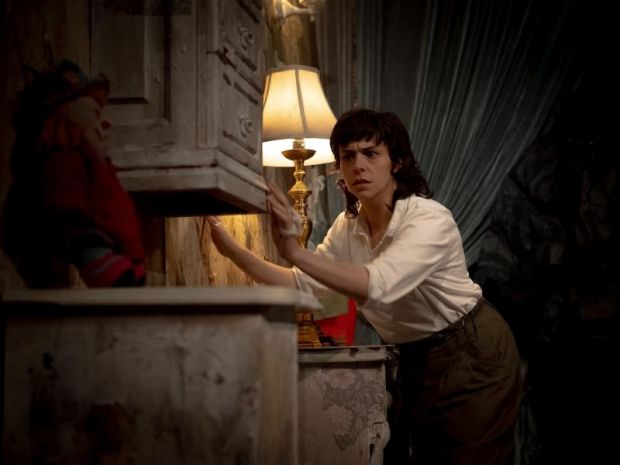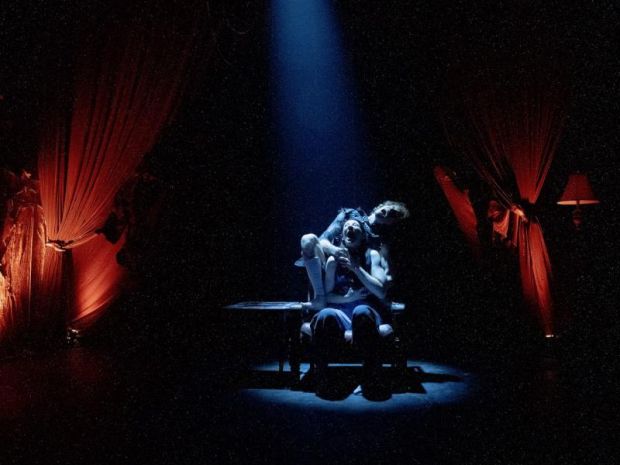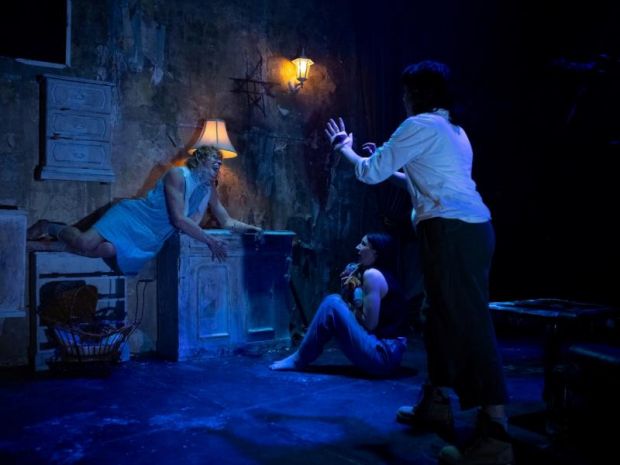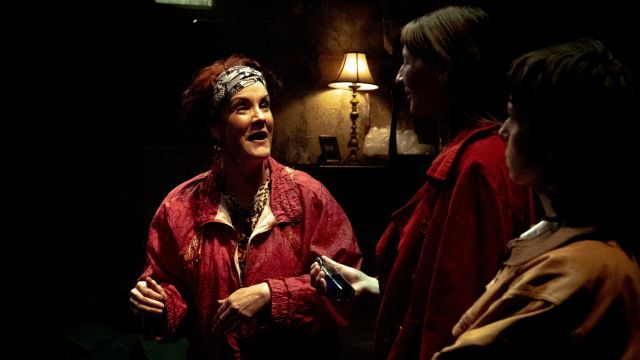Our Monster’s Name is Jerry
This imaginative, risk-taking production takes the tropes of the horror genre to new and original places. Each aspect is integrated into the whole: text, performance, design and sound. It is, of course, frequently shocking, frightening or gruelling, but that’s the intention and the genre. Here, playwright Amy May Nunn traps a gay couple, with an ostensibly ‘normal’ issues, into a haunted house. But is the house haunted - or are they?
Lou (Em Jevons) and Maud (Laura Jane) are a couple deciding they want a family and Maude is trying IVF. But they’re broke (not surprising considering the cost of IVF) and about to lose their home. Fortuitously, Maud inherits a house from a distant relative - whom she scarcely remembers - and so the couple move in. They have no choice – it’s the real estate dilemma for their generation - but for Lou, the locale is ungenial – too pristine, too snooty – and there’s a busybody neighbour, Barb (Amanda LaBonté) always dropping in, knowing your business – and with ‘brews’ for Maud’s health... In clear contrast to the horrors inside - and with a most entertaining performance - LaBonté provides the comic relief – and a source of tension. What are those ‘brews’, coloured blue, that she brings around – and which Maud drinks with cheerful insouciance? And does Barb know more than she’s letting on?

Despite its being in an up-market neighbourhood, the ‘mansion’ is a dump, draped in plastic dust sheets, peeling wallpaper, battered furniture, strange ugly cabinets and cupboards. Most disquieting of all, there is a large bloodstain on one wall... The set, on which almost all the action takes place, is nicely in keeping with the genre, and we recognise it immediately. Design is by Savanna Wegman (working with Maya Anderson). But there are two out-of-keeping rock arches upstage that appear to open into black tunnels. Neither Lou nor Maud seems to notice. One of these tunnels (if that’s the right word) we guess, is the visual representation of a perilous opening into the source of psychic fear, the unconscious, the unadmitted, the repressed traumatic past. (The other archway seems merely to be an exit to the rest of the house – a sign of the somewhat muddled thinking that is symptomatic of Jerry.)
Relying, so director Alanah Guiry says, on Jung’s concept of ‘the Shadow’, the shape shifter monster, called ‘Jerry’, may lurk in the darkness and manifest in an unguarded or low-spirited moment to either Lou or Maud. The name ‘Jerry’ begins as a kind of a joke – best to name your fears, ha-ha - but Jerry becomes – at least for both these characters – all too real. Lou’s repressed memories of childhood cruelties appear. Jevons’ spikey manner contrasts most effectively with her vulnerability and terror. Meanwhile, we might connect Maud with that bloodstain and with something horrific long ago – and as her pregnancy progresses the ‘body horror’ trope becomes more and more disturbing.

One of the most salient challenges for writer and director was and is to put a ‘monster’ on stage. Not Mr Hyde or the being made by Dr Frankenstein (both of which have been successful theatrically), but an abstract and yet visible monster, a metaphor that invades the consciousness of Lou and Maud in different forms. We can imagine Jean Cocteau, say, telling this story in the manner of his La Belle et La Bête – but that’s a movie.
Here, the monster – ‘Jerry’ - is played by Tomas Parrish – and for all their energy, scary, spooky demeanour, and bullying of Lou and Maud, I couldn’t suspend my disbelief so far – or far enough. On Jerry’s first appearance, I had to catch up and realise, ‘Oh, this’s the monster – but here it’s Lou’s repressed fear, a figure from Lou’s past.’ It must be said that it’s a tough call for Parrish; they must shape shift over and over to make Lou’s and Maud’s fears visible, but there seems to be too much talk and undirected and unfocused movement in pursuit of that goal. Jevons and Jane on the other hand, play their everyday selves, problems and their secret fears absolutely straight, making us care for them even when they are stubborn, selfish or lost in the fog of pregnancy.

The problem with Our Monster’s Name is Jerry, for all its imagination, is that it puts its elements, tropes and metaphors – perhaps too many of them - on stage but then doesn’t do quite enough with them. The complexity of the psychologies May Nunn explores and investigates remains intellectual. Is any audience member fearful? Does anyone’s skin crawl? Those visceral, atavistic responses to horror are undercut. The challenge of a monster on stage isn’t quite met.
Does playwright Amy May Nunn want to say you can give your monster a name, but she/he/it will never go away? Was it bad luck that Lou and Amy moved into this house? Or would there be a Jerry wherever they go? At the end, although we’ve been entertained by the performances and the ideas, and we’ve had some fun despite the underlying seriousness of it all – there are a few too many loose ends.
Michael Brindley
Photographer: Kimberly Summer
Subscribe to our E-Newsletter, buy our latest print edition or find a Performing Arts book at Book Nook.

